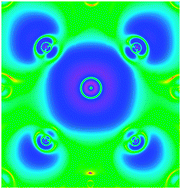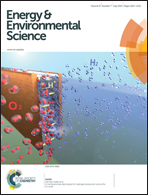P-type doping of elemental bismuth with indium, gallium and tin: a novel doping mechanism in solids†
Abstract
A new doping mechanism is described, whereby a doping impurity does not simply transfer charge to the bands of a host semiconductor or semimetal, but rearranges the core energy levels deep in the valence band of the host. This, in turn, leads to a redistribution of all electrons in the host, and, if designed properly, changes the location of the Fermi level EF and the density of conducting charge carriers near EF. The principle is proven experimentally in elemental Bi, whereby group III elements In and Ga dope Bi p-type, in spite of the fact that all three atoms are trivalent in the solid state. Electronic structure calculations show the formation of a hyperdeep defect state (HDS) and its effect on the EF in Bi doped with In (Bi:In) and Ga (Bi:Ga). The HDS at ∼5 to 6 eV below the EF of elemental Bi hybridizes with the Bi 6p electrons, and deprives the Bi valence band of two electrons per impurity atom. This then perturbs the electron count in the solid and lowers the EF. The charge on the impurity atoms is unchanged. In principle, this doping action does not result in the appearance of ionized impurities that scatter conduction electrons and holes in conventional doping. Experimentally, Shubnikov–de Haas and Hall Effect measurements show that adding In to Bi results in an increase in the density of holes. Thermoelectric, galvanomagnetic and thermomagnetic data are given for single-crystal and polycrystalline samples. In-doping leads to an enhancement of the thermoelectric figure of merit, which suggests that the new doping mechanism also gives a route to develop better thermoelectric materials. The same mechanism is at work for Sn-doped Bi (Bi:Sn), although here ionized impurity scattering is not avoided.


 Please wait while we load your content...
Please wait while we load your content...